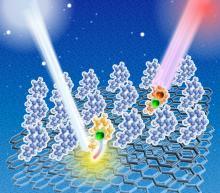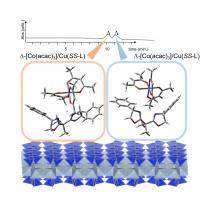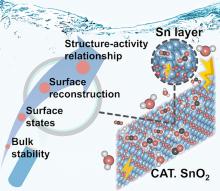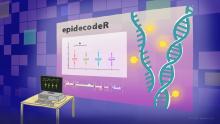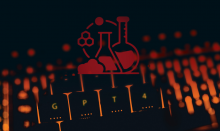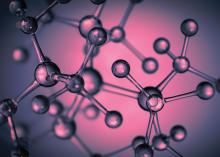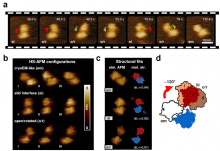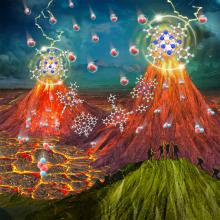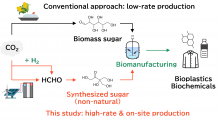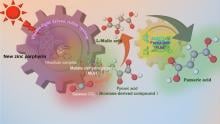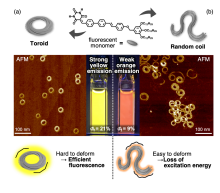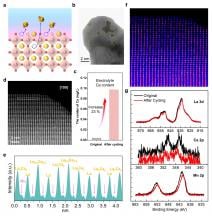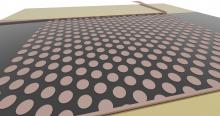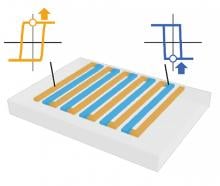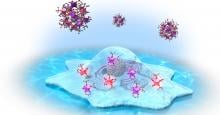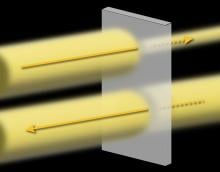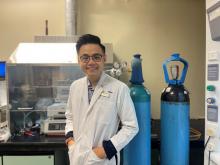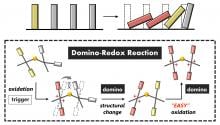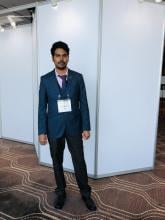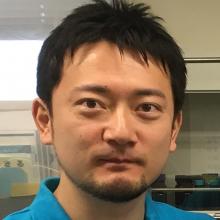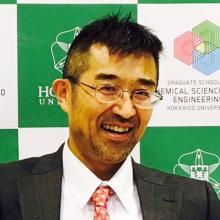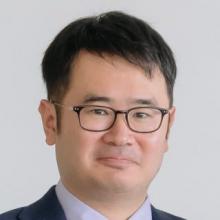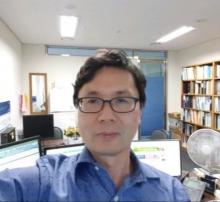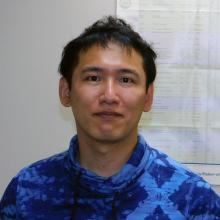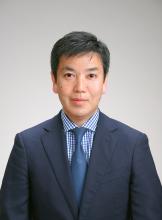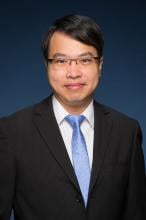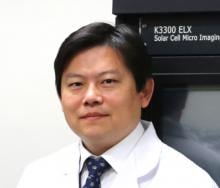Chemistry
News
15 Mar 2024
A packing material has been developed for chromatographic resolution on the basis of a clay mineral. The material is an adduct of chiral Cu(II) complex and synthetic hectorite.
08 Mar 2024
In a new step towards combating climate change and transitioning to sustainable solutions, a group of researchers has developed a research paradigm that makes it easier to decipher the relationship between catalyst structures and their reactions.
05 Mar 2024
A novel method for studying genes in testicular cells of living animals could lead to breakthroughs in male contraception and fertility treatments.
28 Feb 2024
A new user-friendly tool helps researchers explore how gene activity is influenced by chemical modifications, providing insights into disease and paths to new treatments.
28 Feb 2024
Molecules that are induced by light to rotate bulky groups around central bonds could be developed into photo-activated bioactive systems, molecular switches, and more.
26 Feb 2024
GPT-4 shows promise as an aid to chemistry researchers, yet its limitations reveal the need for further improvements.
26 Feb 2024
Researchers have developed an AI-driven system that can design novel molecules with any desired properties and suggest methods to create them using readily available materials.
23 Feb 2024
A German aircraft flying out of Cairns is measuring the chemistry of the clouds above Australia and the Pacific.
22 Feb 2024
Researchers from Nano Life Science Institute (WPI-NanoLSI), Kanazawa University report in Nature Communications that TMEM16F, a transmembrane protein that facilitates the passive movement of phospholipids and ions across membranes, explores a larger conformational landscape than previously thought to perform its unique functions. The finding refines our molecular understanding of crucial physiological processes such as blood coagulation and COVID-19 pathogenesis, and highlights the importance of probing membrane proteins in native-like environments.
21 Feb 2024
Metal-nitrogen-carbon (M-N-C) single-atom catalysts are a promising type of catalyst that could help provide cost-effective alternatives to platinum-based ones. However, there are still some aspects of their behavior that are misunderstood. To rectify this, a group of researchers delved into the intricacies of M-N-C catalysts, yielding promising results.
16 Feb 2024
At Xi’an Jiaotong-Liverpool University, four researchers in diverse fields of study – from urban planning to digital architecture – are working hard to reach sustainability goals.
15 Feb 2024
Coordination polymer crystals show promise as a new generation of light sources for industry and medicine.
14 Feb 2024
Researchers from Osaka University and collaborating partners succeeded in biomanufacturing from chemically synthesized sugar for the first time in the world. With refinement of this technology, one can envision a future society in which the sugar required for biomanufacturing can be obtained "anytime, anywhere, and at high rate". In the future, biomanufacturing using chemically synthesized sugar is expected to be a game changer in the biotechnology field—including the production of biochemicals, biofuels, and food, where sugar is an essential raw material—ultimately leading to the creation of a new bio-industry.
14 Feb 2024
An innovative and more efficient way to produce fumaric acid that not only reduces carbon dioxide emissions, but also reuses waste resources to make biodegradable plastics
13 Feb 2024
The properties of supramolecular polymers are dictated by the self-assembled state of the molecules. However, not much is known about the impact of morphologies on the properties of nano- and mesoscopic-scale polymeric assemblies. Recently, a research team demonstrated how terminus-free toroids and random coils derived from the same luminescent molecule show different photophysical properties. The team also presented a novel method for purifying the toroidal structure.
13 Feb 2024
AI records rare bird footage, Lighting up IoT and smart cities, Crystal language designs new materials, Detecting toxins with mobile phones, and Dragonfly wings for better aerodynamics. Plus join us for SciCom coffee. Read all in the latest Editor's Choice.
08 Feb 2024
Perovskite oxides have been touted as an alternative to noble metal catalysts. However, their application is still hampered by their poor electrical conductivity and low specific surface area. Now, a research team has created a new method that improves this, facilitating their application in hydrogen fuel cells.
05 Feb 2024
A key innovation in photonic (light-driven) microelectromechanical components could transform computing technology, increasing efficiency while reducing power consumption and chip size.
01 Feb 2024
A collaborative group of researchers has potentially developed a means of controlling spin waves by creating a hexagonal pattern of copper disks on a magnetic insulator. The breakthrough is expected to lead to greater efficiency and miniaturization of communication devices in fields such as artificial intelligence and automation technology.
31 Jan 2024
Carbon nanostructures could become easier to design and synthesize thanks to a machine learning method that predicts how they grow on metal surfaces. The new approach, developed by researchers at Japan’s Tohoku University and China’s Shanghai Jiao Tong University, will make it easier to exploit the unique chemical versatility of carbon nanotechnology.
26 Jan 2024
- Joint research team of DGIST (Prof. Dae-hyun Nam, Youn-gu Lee) - Sogang Univ. (Prof. Seo-in Back) developed a new catalyst for electrochemical reduction of carbon dioxide using “vitamin C boosting copper nanowire”
- Utilizing the jointly developed catalyst accelerates conversion from carbon dioxide to ethylene, enabling mass production of ethylene
- Findings published in the prestigious academic journal, “Nature Communications”
26 Jan 2024
- DGIST Prof. Park Jin-hee and her team detected unknown sample components by analyzing color change patterns and developed a technology that allows analyzing concentrated amounts through a mobile phone camera
- Expected to secure source technologies and open new avenues in the environmental sensor field
23 Jan 2024
Scientists are eager to harness the unique electrical properties of topological magnets for advancing thermoelectric materials. A collaborative research group has successfully induced positive and negative polarities, unlocking the potential for generating thermoelectric energy from materials with topological magnet properties.
22 Jan 2024
A water-soluble, luminescent europium complex enables evaluation of malignancy grade in model glioma tumor cells.

19 Jan 2024
Temperature-controlled, reversible shifting of molecular gear motion in a solid crystal opens new possibilities for material design.
18 Jan 2024
A research group led by Osaka Metropolitan University has discovered significant nonreciprocal optical absorption of LiNiPO4, referred to as the optical diode effect, in which divalent nickel (Ni2+) ions are responsible for magnetism, by passing light at shortwave infrared wavelengths used in optical communications. Furthermore, they have uncovered that it is possible to switch the optical diode effect by applying a magnetic field. This is a step forward in the development of an innovative optical isolator that is more compact and can control light propagation, replacing the conventional optical isolators with complex structures
15 Jan 2024
Research by Assistant Professor Edison Ang Huixiang and his team from National Institute of Education/Nanyang Technological University Singapore
15 Jan 2024
Unleashing stem cells from dog urine, Electronic Tongue, Tapping into human motion energy, How neurons network, and A radical use for plastic bags. Plus Communicating science two decades on. Read all in the latest Editor's Choice.
09 Jan 2024
Transmitting an effect known as a domino reaction using redox chemistry has been achieved for the first time.
Events
Sorry, nothing coming up for this discipline
Researchers
Nimanthi Jayathilaka is a professor at the Department of Chemistry, University of Kelaniya, Sri Lanka.
Dr. Mashura Shammi is an associate professor at the Department of Environmental Sciences, Jahangirnagar University, Bangladesh.
Hira Khalid is an associate professor at the Department of Chemistry of Forman Christian College University, Lahore, Pakistan.
Ordered Functional Materials, like, COFs, COPs, CTFs for membrane applications (soft actuators and energy storage & conversion)
Madoka Ono is an associate professor at the Research Institute for Electronic Science/Green Nanotechnology Research Center at Hokkaido University and is the principal researcher at AGC Inc. Materials Integration Laboratories.
Associate Prof. Yusuke Ishigaki is a chemist at Hokkaido University, Japan. He works on the creation of fundamental chemistry based on original molecular design.
Prof. Takanori Suzuki is a chemist at Hokkaido University, Japan. His research looks at the construction of record-breaking strained compounds and the development of unimolecular memory.
Tsuyoshi Mita is a specially appointed associate professor at the Institute for Chemical Reaction Design and Discovery (WPI-ICReDD), Hokkaido University, Japan.
Shinya Furukawa is an associate professor at the Institute for Catalysis, Hokkaido University, Japan.
Jong-Sung Yu is a professor at the Department of Energy Science and Engineering, Daegu Gyeongbuk Institute of Science & Technology (DGIST), South Korea.
Her current research focuses on design and synthesis of metal-organic frameworks and metal-organic polyhedra for sustainable energy and environment.
A pioneering researcher in Systems Chemistry for autonomous behavior in multi-molecular systems. The interdisciplinary field of chemistry and physics can be contributes the development in micro-robotics and comprehension of origin-of-life.
Manabu Tokeshi is a Professor at the Division of Applied Chemistry at Hokkaido University.
Dr. Simon Quan-Bin Han is an Assistant Professor at the School of Chinese Medicine, Hong Kong Baptist University.
Prof. Yuichi Kitagawa is a specially appointed lecturer at the Institute for Chemical Reaction Design and Discovery (ICReDD), Hokkaido University, Japan.
Dr. Leung is an Associate Professor and Programme Director at the Department of Chemistry, The Hong Kong Baptist University (HKBU), Hong Kong SAR, P. R. China. He concurrently holds the Honorary Associate Professorship at the Faculty of Dentistry, The University of Hong Kong (HKU). He is a Chartered Scientist, Chartered Chemist of the Royal Society of Chemistry in UK and a member in the State Key Laboratory of Environmental and Biological Analysis at HKBU. He was elected as a Founding Member of The Hong Kong Young Academy of Sciences. His research interests are in the field of supramolecular chemistry, organic materials catalysis, nanoscience, and nanomedicine.
Prof. SU-IL IN has been working at DGIST (Daegu Gyeongbuk Institute of Science & Technology) since 2012. He served as Dean of International and External Affairs 2016 ~ 2017. He received his Ph.D. in Chemistry from University of Cambridge in 2008. Subsequently he was a postdoctoral researcher at Technical University of Denmark by 2010. Then he joined the Pennsylvania State University as a postdoctoral researcher in the Department of Chemistry before joining DGIST. Professor In’s current researches include synthesis and analysis of functional nano (bio)-materials for environmentally friendly renewable energy such as photovoltaic, heterogeneous catalysis and biocatalysts. (https://insuil.dgist.ac.kr/)
Dr. Omachi is Associate Professor, Research Center for Materials Science, Nagoya University
Giants in history
Sorry, nothing coming up for this discipline


